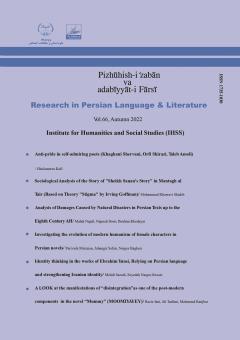-
-
List of Articles
-
Open Access Article
1 - Anti-pride in self-admiring poets (Khaghani Shervani, Orfi Shirazi, Taleb Amoli)
Gholamreza Kafi -
Open Access Article
2 - Sociological Analysis of the Story of "Sheikh Sanan's Story" in Mantagh al Tair (Based on Theory "Stigma" by Irving Goffman)
Mohammad Khosravishakib -
Open Access Article
3 - Analysis of Damages Caused by Natural Disasters in Persian Texts up to the Eighth Century AH
Mehdi Najafi Najmeh Dorri Ebrahim Khodayar -
Open Access Article
4 - Investigating the evolution of modern humanism of female characters in Persian novels
Parivash Mirzaeyan jahangir safari Narges Bagheri -
Open Access Article
5 - Identity thinking in the works of Ebrahim Yunsi, Relying on Persian language and strengthening Iranian identity
Mehdi Saeedi Seyedeh Narges Rezaie -
Open Access Article
6 - A LOOK at the manifestations of “disintegration”as one of the post-modern components in the novel “Mummy ” (MOOMIYAYEY)
razie fani Ali Taslimi Mahmoud Ranjbar
-
The rights to this website are owned by the Raimag Press Management System.
Copyright © 2017-2025







